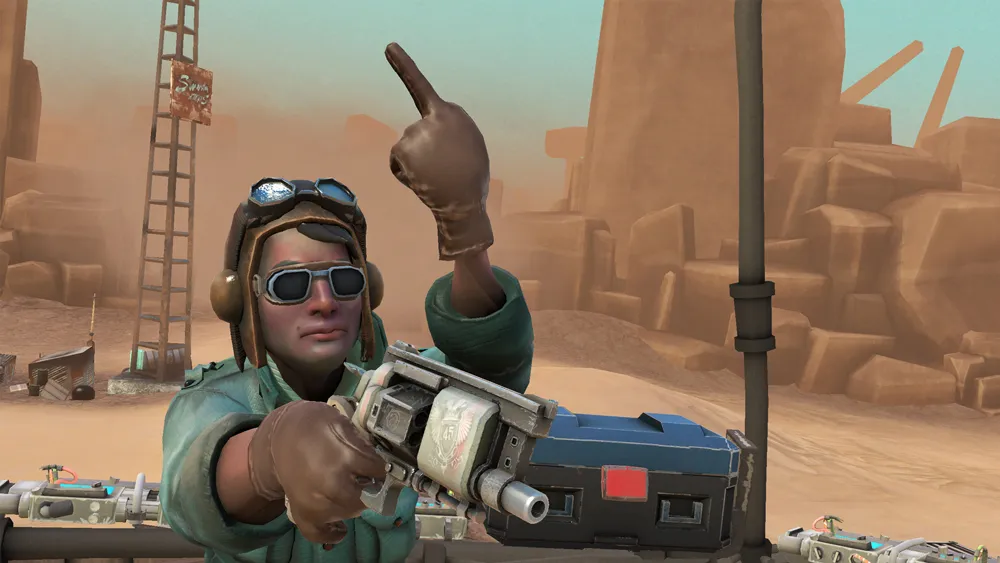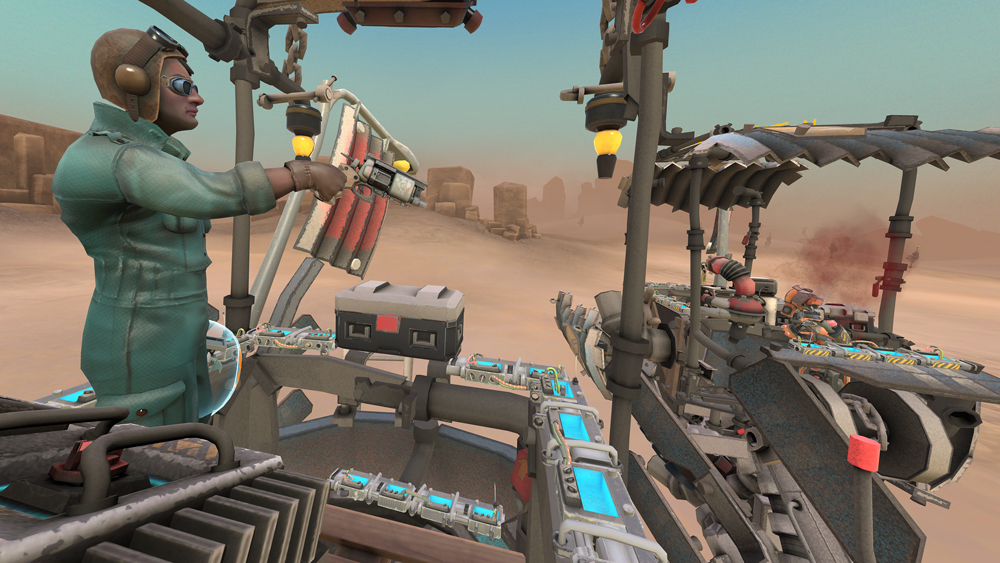I crouch down to take cover, my opponent firing wildly in my direction. I’m able to see a sliver of her avatar through the cracks in her defense. I take aim and quickly move up for a better angle, unloading six blasts from my dual wielded shotguns along the way.
I see one or two shots connect as I dip down behind my cover again to avoid her return fire, flipping my barrels open to reload. I knock down part of her cover during the last attack, leaving her wide open. I take aim, fire, boom – junkyard. I laugh and flip her off in the game as her ship explodes.
“Hey Will, turn around.” Brandon Laatsch says in my right ear.
As I wheel around I only have half a second to see the barrels of dual shotguns pointed directly at me, I can feel his smirk as he pulls the triggers. My victory was short lived.
That thrilling 30 seconds was only a small portion of the straight hour I spent inside Hover Junkers, but it encapsulates so many of the things that make the game so entrancing in VR.
https://www.youtube.com/watch?v=kdPfHrPUc40
Taking place in the “somewhat near future when humans have exhausted all the fresh water supply,” Hover Junkers is a first person shooter with a heavy emphasis on multiplayer combat. In the game you and up to seven others battle against each other on hovering ships that act as your cover and movement through the game’s environment.
Throughout the game you find pickups that allow you to line the outside of your ship with various forms of cover – from worn out air conditioning units to giant I-beams. The pieces snap in easily to grooves along the edges of the ships allowing you to quickly replace cover in the middle of a firefight or move pieces around. In addition to placing cover on your ship, you can also store junk you find as loot, which goes into your overall score for the game. Balancing defending yourself, killing your opponents and scoring loot makes up a good bit of the game’s strategy.
It’s Not Like An Action Movie
Speaking of firefights, you’re going to be involved in a lot of them during the game, and they are much harder than any first person shooters you’ve ever played before. Traditional FPS games typically use some form of auto-aiming or aim assist to help players more easily hit their targets. Not the case with Hover Junkers. Where you aim your gun is where it shoots, for better or worse.
“If we took a professional Call of Duty player and a professional handgun marksman and pitted them against each other, I’m pretty sure who would win,” laughs Alex Knoll, the game’s director and designer.
That is not to say the game isn’t accessible, it just adds an extra layer of challenge in that you are in an actual gunfight – something action movies make look a lot easier than it really is.
Despite being somewhat more difficult than your average shooter, the controls are incredibly natural and I managed to pick everything up very quickly. Reloading is different for the revolver and shotgun, but in a way that makes sense. With the revolver, for example, it’s a click of the touchpad and then a clockwise spin of your finger to eject the spent bullets and reload them. It certainly takes longer than your average push a button to reload but that only adds to the tension of the fight.
[gfycat data_id=”FrightenedGrayAmazondolphin” data_autoplay=true data_controls=false align=middle]
Multiple times during my playthrough I found myself so lost in the combat that my fight or flight instincts kicked in and my adrenaline spiked. After an hour of playing I emerged with a bead of sweat on my brow and a giant smile on my face. I could’ve sworn it had only been about 20 minutes.
“We put a clock in there,” laughs Laatsch, “but I guess you didn’t see it.”
Scaling for All
Hover Junkers was designed for VR with tracked controllers and scaleable room-scale in mind. “It can be played seated, standing, small, medium, large, huge spaces,” said Knoll. “We want to accommodate everyone’s setup and VR space so our design process has lead to creating a flexible user experience since everyone’s space and tracking setup could vary.”
You can select from 17 different ships in varying sizes from “tiny” to “huge.” The team says that picking one that approximately matches your play area will result in the better experience. They also make heavy use of a tool “gun” which can be used to pick up and place objects at a distance as well as to access in game stats, and most importantly, drive your ship.
Moving beyond your playspace has been an issue developers have tried to solve for room scale VR, making use of a number of techniques from flipping the room when you reach the end, to “blinking,” to “ghosting,” but none of these are appropriate for the fast-paced motion in a first person shooter. Stress Level Zero turned a problem into a solution, matching your ship size to the room dimensions so you can freely walk around in the game.
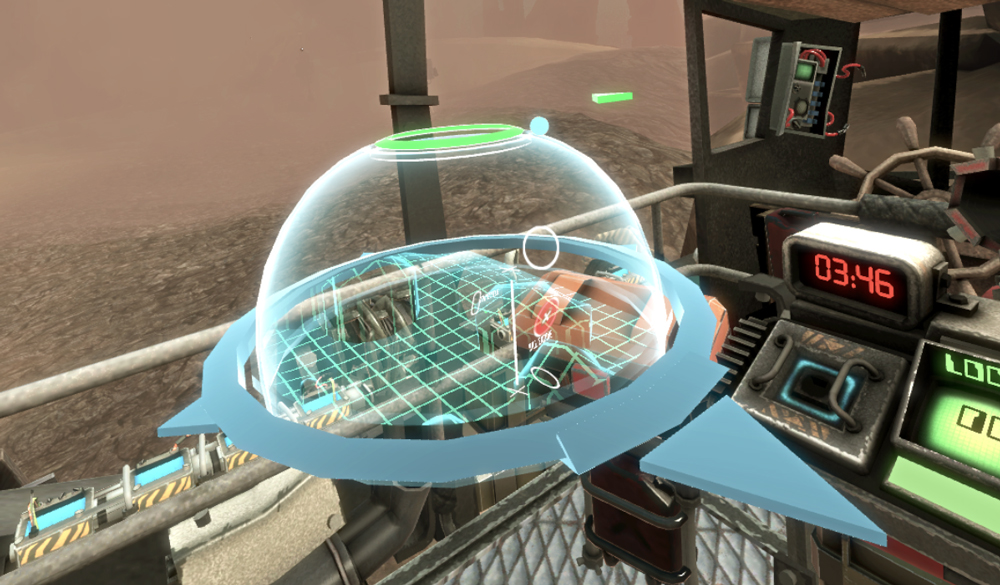
When you place the multitool gun on top of the key ignition on your ship and pull the trigger, it essentially turns your controller into a free motion joystick. Tilting the controller forward moves you forward, tilting it to the right moves you right, etc. There is a constant speed and plenty of frames of reference around you so the movement never feels jarring or nauseating. Perhaps more importantly, it feels effortless and natural. After a short while of controlling my ship, I didn’t even have to think about how to move it – it was as second nature as pressing forward on a thumbstick. In addition to turning your controller into a joystick, it brings up a holographic mini map attached to the top, which makes navigation a breeze.
Room Scale Social Presence
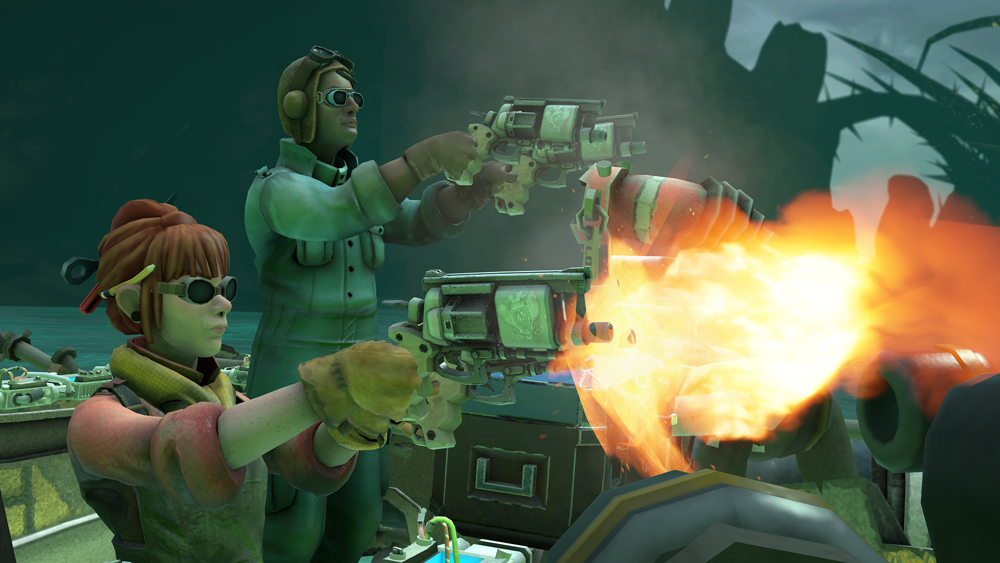
One of the things that Hover Junkers gets very right is social presence.
From your perspective as a player, your avatar is represented by your floating hands however from an outsider’s view you are actually a full avatar, complete with body movement through a custom inverse kinematics (IK) engine. This allows you to have a target as well as give life to the other players in the match while avoiding the pitfalls that come with first person IK. The moment you try to do a chicken dance and your elbows don’t bend right would break the immersion quickly.
The player interaction is fantastic in Hover Junkers, you can really feel there is an actual person living behind the avatar. In the waiting room between matches, for example, all the avatars are represented as simply floating hands and goggles, but we still managed to screw around with each other. From using your hands to cover someone’s eyes in front of you, to giving them the middle finger afterward, there is a lot more to the interactivity than just voice.
One criticism I did have with the current build of the game in respect to social, is is a lack of variety of avatar models. With up to eight people in a single game, and only three avatars currently available to choose from, it removes some individuality from each of the characters. This is mitigated somewhat by having many different ship configurations to choose from, but is something I would love to see improved by the time the game ships in April.
One thing I did not get to test, but is a part of the game, is the ability to play co-op on a single ship. Right now you can have up to two players per ship which opens up a number of interesting strategies. For example, one player could handle the driving while the other dual wields and goes on the full offensive.
Multiplayer is fun, but it’s ok to roll solo
While Stress Level Zero is focused mainly on the multiplayer aspect of Hover Junkers, they are also building a single player mode as well.
According to Knoll it will be a “VR adventure… which can be offered as a somewhat relaxing break between long multiplayer sessions.”
The game mode will be “similar to Oregon Trail mixed with some Grapes of Wrath,” he said where you and a group of NPCs try to survive out in the harsh wasteland of Junk Road. You will select a profession, your items and supplies you will bring along with you as you search for a new planet to settle on. Like Oregon Trail there will be events that happen along the way that will hamstring your journey such as NPCs getting sick or your ship catching fire. You will also have to manage your supplies throughout the journey to ensure the survival of your whole crew.
This mode wasn’t available for testing when I had a chance to go hands on, but Stress Level Zero says it will be included in the game’s final release.
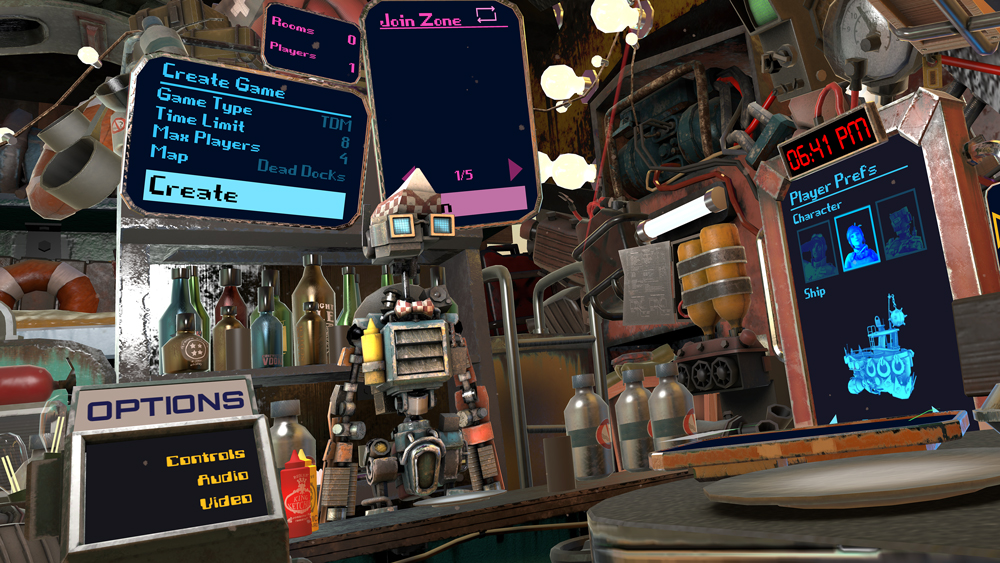
Nobody would necessarily call Hover Junkers in its current state a deep first person shooter. There are currently only two guns that you can pick from, and the combat is fairly straight forward despite there being multiple schools of thought on the best strategy (sharp shooters may try to play at a distance, while others may choose to circle an opponent closely like a shark – for example). However its simplicity is one of its greatest assets.
Hover Junkers is the kind of accessible title that anyone can play, but fewer will master. Stress Level Zero wants to focus on this even playing field for the game’s launch.
“For launch,” Knoll said, “the player’s level won’t affect anything besides bragging rights; everyone will have access to every ship and every level immediately we have in the game.” He does mention that down the road they may add more unlockables with player leveling but, “at launch [they] don’t want to separate anyone.” Which makes sense given the game’s audience will likely be relatively small at the start and will be filled with many people who are new to VR.
Many of the room scale VR experiences I have had a chance to play have been impressive, but aren’t necessarily titles I would see myself returning to time and time again. Hover Junkers is easily one of the best multiplayer titles for the HTC Vive so far, the kind of game that makes you want to keep coming back for more – and that is something that VR really needs to succeed.
Hover Junkers is currently available for pre-order on Indiegogo for $35. The game will be released initially on the HTC Vive with plans to add support for the Oculus Rift when Touch is released later this year.
Correction: A previous version of this article listed Alex Knoll as the game’s lead programmer. He is the game’s director, the article has been updated to reflect that.

